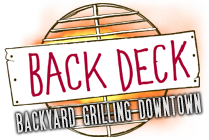Indirect heat: This is when the fire is not directly under the item being grilled. On a regular covered grill this is done either by building the fire on one side and putting the food to be indirectly cooked on the other or with the fire at the edges and a drip pan in the middle to catch grease which would cause a flare-up, producing higher temperatures and lots of soot which will make your food unattractive. In both cases the cover is on and the vents part way open. The vents, top and bottom, can be adjusted to regulate the temperature inside. This is how I often cook ribs, usually after I’ve grilled something else over a regular fire, banking the coals to one side, adding a piece of hardwood for smoke (yes, indirect grilling is pretty close to hot smoking) and keeping the fire low and the vents almost closed for about 3 hours.
A whole chicken can be done this way, as can a prime rib, or any food that needs a long, slow cooking. Sometimes I’ll do my Thanksgiving Turkey over charcoal – turkey loves a little smoke. Of course with charcoal this doesn’t mean you put the chicken or roast on the fire and walk away. You need to keep a close eye on the temperature, adjusting the vents and adding charcoal as needed to keep the heat under the lid at 350º or so.
Griddle: A griddle accessory for your grill opens up the possibility of grilling eggs, pancakes, omelets and almost anything else you can cook in a frying pan. A griddle is just a thick slab of seasoned cast iron or steel that you place over the grate. One thing to think about, just like direct grilling, is a hot and cool zone. Do you want to have a very hot section of you griddle for eggs and such, and a medium warm section for grilled cheese sandwiches and pancakes? If so you will need to bank more coals under one side of the griddle than the other.
Smoking: I kind of already covered this under indirect cooking, except that there are grills built for smoking that have a separate chamber for the burning coal and wood, slightly lower than the main chamber, and connected with the vent – or smoke stack – at the other end so the hot air and smoke travel through the main chamber.
Packages: The idea here is that the food inside the packet will cook in it’s own juices. Over a hot fire the food inside packets can burn. Since you can’t see inside while the food is cooking you can to be very careful. Packets need to be turned regularly and watched constantly. If you start to see charring on the outside of the packet then you probably have burning on the inside. Keep packets away from a high direct heat. Upper racks and cooler areas of the grill are best.
Directly on the coals: Yes, you can throw away those grates, take a nice thick steak, season it, oil it and put it directly on the coals. What does this accomplish? As you might imagine, it sears the outside quickly while adding a smoky flavor. The interesting thing is that a fatty piece of meat, like a rib eye, on the grates will cause flare-ups, but when placed directly on the coals the fats that melt don’t have enough oxygen to create flames, and instead smolder, adding the smoky taste. Many years ago, when I worked at George Germon and Johanne Killeen’s fabulous restaurant Al Forno in Providence, we did a porterhouse like this which they named a “dirty steak.” And how dirty is it? Well, it does pick up some soot, and it even will have some still glowing embers attached, but a quick brushing with olive oil cleans off all the “dirt.” If you like your steak black and blue this is the way to go.
